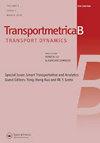网联自动驾驶车辆自主交叉口管理与轨迹平滑设计联合优化
IF 3.4
2区 工程技术
Q2 TRANSPORTATION
引用次数: 1
摘要
本文章由计算机程序翻译,如有差异,请以英文原文为准。
Joint optimization for autonomous intersection management and trajectory smoothing design with connected automated vehicles
Trajectory smoothing design (TSD) may significantly reduce fuel consumption and improve driving comfort at intersections. In this paper, a mixed integer linear programming (MILP) model with discrete time is formulated to jointly optimize autonomous intersection management and TSD, aiming to improve traffic efficiency, fuel economy and driving comfort simultaneously. Driving safety of car-following and collision avoidance at conflict points, diverge points and converge points, as well as constraints of acceleration and jerk are considered. To reasonably describe vehicle movement within intersection areas, the vehicle trajectory within the intersection is treated as a channel considering the vehicle width. A rolling horizon framework is used to solve the model. We have compared the traffic efficiency, fuel economy, monetary cost and driving comfort of the joint optimization model with that of the state-of-the-art two-stage strategy. Finally, sensitivity analysis with respect to left-turn ratio, weighted coefficient of TSD and control zone length is conducted.
求助全文
通过发布文献求助,成功后即可免费获取论文全文。
去求助
来源期刊

Transportmetrica B-Transport Dynamics
TRANSPORTATION SCIENCE & TECHNOLOGY-
CiteScore
5.00
自引率
21.40%
发文量
53
期刊介绍:
Transportmetrica B is an international journal that aims to bring together contributions of advanced research in understanding and practical experience in handling the dynamic aspects of transport systems and behavior, and hence the sub-title is set as “Transport Dynamics”.
Transport dynamics can be considered from various scales and scopes ranging from dynamics in traffic flow, travel behavior (e.g. learning process), logistics, transport policy, to traffic control. Thus, the journal welcomes research papers that address transport dynamics from a broad perspective, ranging from theoretical studies to empirical analysis of transport systems or behavior based on actual data.
The scope of Transportmetrica B includes, but is not limited to, the following: dynamic traffic assignment, dynamic transit assignment, dynamic activity-based modeling, applications of system dynamics in transport planning, logistics planning and optimization, traffic flow analysis, dynamic programming in transport modeling and optimization, traffic control, land-use and transport dynamics, day-to-day learning process (model and behavioral studies), time-series analysis of transport data and demand, traffic emission modeling, time-dependent transport policy analysis, transportation network reliability and vulnerability, simulation of traffic system and travel behavior, longitudinal analysis of traveler behavior, etc.
 求助内容:
求助内容: 应助结果提醒方式:
应助结果提醒方式:


